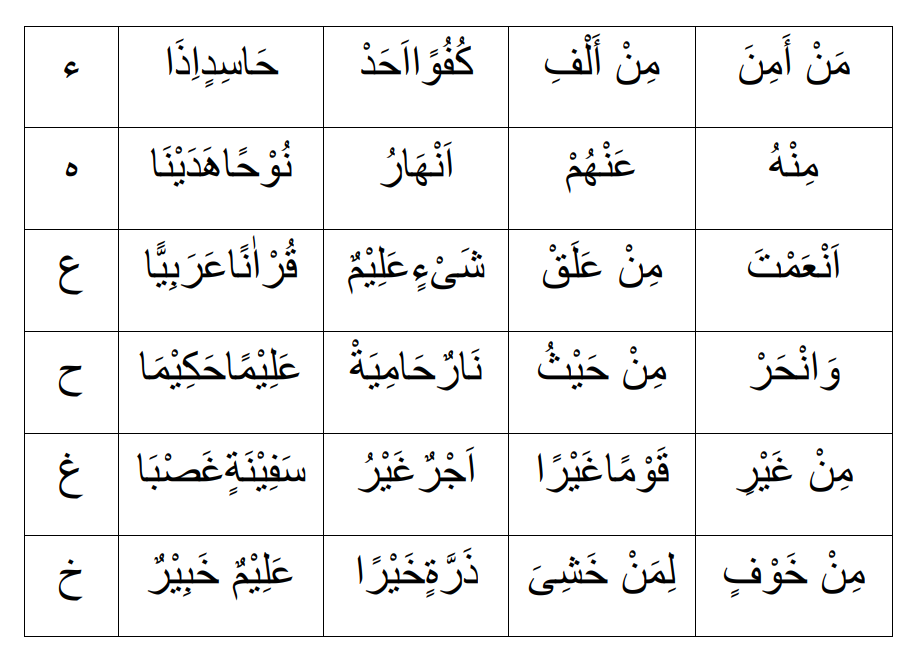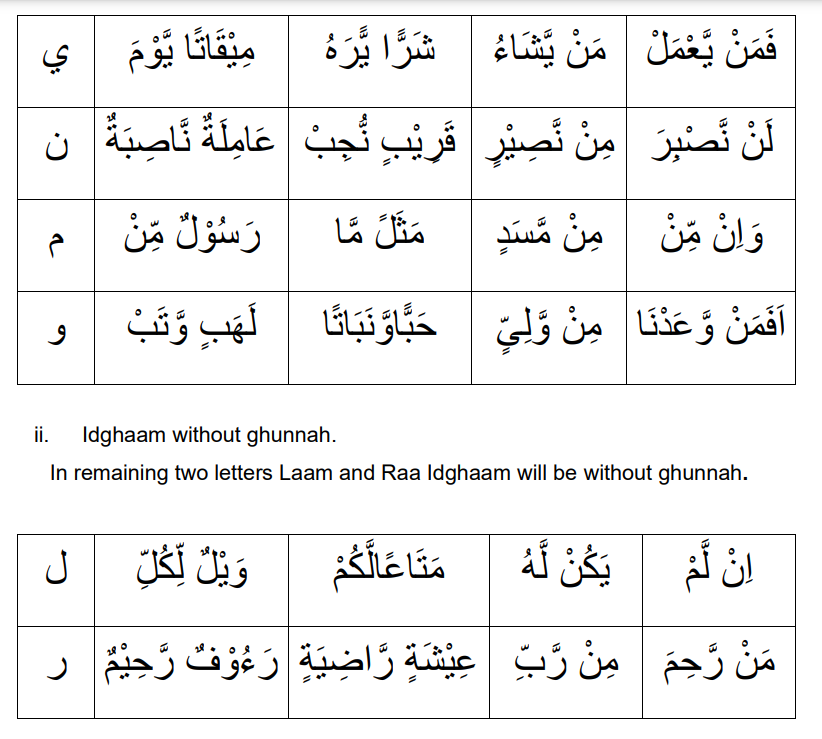Tajweed is the science of reciting the Quran correctly, ensuring that each letter is pronounced with its proper characteristics and articulation. This helps in preserving the Quran as it was revealed and prevents errors that could change meanings. Two fundamental aspects of Tajweed are Makharij Al-Huruf (Articulation Points of Letters) and Sifat Al-Huruf (Characteristics of Letters). Understanding these will significantly improve your recitation.
Basic Rules of Tajweed
Tajweed consists of several rules that guide proper pronunciation and recitation. Some essential ones include:
1. Noon Sakinah and Tanween Rules
| Rule | Description |
|---|---|
| Izhar (Clear Pronunciation) | When Noon Sakinah or Tanween is followed by throat letters (ء, ه, ع, ح, غ, خ), it is pronounced clearly. |
| Idgham (Merging) | When Noon Sakinah or Tanween is followed by ل, ر, ي, م, و, ن, the sound merges into the next letter. |
| Iqlab (Conversion) | When followed by ب, Noon Sakinah or Tanween changes into a Meem sound with slight nasalization. |
| Ikhfa (Concealment) | When followed by any other letters, the Noon sound is lightly hidden with nasalization. |
Example of Izhar :

Example of Idgham :

Example of Iqlab :

Example of Ikhfa :

2. Meem Sakinah Rules
| Rule | Description |
|---|---|
| Ikhfa Shafawi | If Meem Sakinah is followed by ب, it is pronounced with slight nasalization. |
| Idgham Shafawi | If followed by another Meem, it is merged with full nasalization. |
| Izhar Shafawi | If followed by any other letter, it is pronounced clearly. |
3. Qalqalah (Echoing Letters)
Qalqalah occurs when the letters ق, ط, ب, ج, د appear with sukoon or at the end of a word. The sound is echoed slightly.
4. Madd (Elongation of Letters)
| Type | Duration | Example |
|---|---|---|
| Madd Tabee’i (Natural Lengthening) | 2 beats | قَالَ |
| Madd Munfasil (Separated Lengthening) | 4–5 beats | إِنَّا أَعْطَيْنَاكَ |
| Madd Muttasil (Connected Lengthening) | 4–5 beats | السَّمَاءُ |
| Madd Laazim (Compulsory Lengthening) | 6 beats | دَآبَّةٌ |
Makharij Al-Huruf (Articulation Points of Letters)
Makharij refers to the places in the mouth, throat, and lips where each Arabic letter originates. Understanding this is crucial for correct pronunciation.
1. The Five Main Areas of Articulation
| Area | Letters Produced |
|---|---|
| Throat (Halaq) | ء, ه, ع, ح, غ, خ |
| Tongue (Lisan) | ق, ك, ج, ش, ض, ل, ن, ر, ط, د, ت, ص, ز, س |
| Lips (Shafatayn) | ف, ب, م, و |
| Nasal Cavity (Khaishoom) | Ghunnah sound (nasalization in Noon and Meem) |
| Oral Cavity (Jauf) | Long vowels (ا, و, ي) |
2. Detailed Breakdown of Makharij
| Letter Group | Specific Makharij |
|---|---|
| Deep Throat | ء, ه |
| Middle Throat | ع, ح |
| Lower Throat | غ, خ |
| Back of the Tongue | ق, ك |
| Middle of the Tongue | ج, ش, ي |
| Sides of the Tongue | ض |
| Tip of the Tongue | ل, ن, ر, ط, د, ت, ص, ز, س |
| Lips | ف, ب, م, و |
Sifat Al-Huruf (Characteristics of Letters)
Sifat refers to the attributes of letters that define how they are pronounced. Each letter has distinct characteristics that must be followed.
Two Categories of Sifat
Sifat are divided into two main types:
A. Sifat with Opposites
| Attribute | Opposite | Description |
|---|---|---|
| Hams (Whispering) | Jahr (Audibility) | Some letters are pronounced with soft air flow, while others are more audible. |
| Shiddah (Strength) | Rikhaawah (Softness) | Some letters are pronounced with a strong stoppage, while others are soft. |
| Isti’laa (Elevation) | Istifal (Lowering) | Some letters are heavy (full-mouthed), while others are light. |
| Itbaq (Adhesion) | Infitah (Opening) | Some letters are pronounced with the tongue pressed to the roof of the mouth. |
B. Sifat without Opposites
These are unique characteristics of certain letters.
| Attribute | Letters |
|---|---|
| Qalqalah (Echoing) | ق, ط, ب, ج, د |
| Ghunnah (Nasal Sound) | ن, م |
| Tafkheem (Heavy Sound) | خ, ص, ض, غ, ط, ق, ظ |
Importance of Understanding Makharij and Sifat
1. Prevents Mistakes in Recitation
A slight mispronunciation can completely change the meaning of words in Arabic, leading to misunderstandings or even incorrect interpretations of Quranic verses. For example:
- قلب (Qalb – Heart) vs كلب (Kalb – Dog)
- عالم (Aalim – Scholar) vs عام (Aam – General) This is why mastering the characteristics of letters is essential for preserving the correct meanings of words and ensuring accurate recitation.
2. Enhances Beauty in Recitation
Understanding Sifat helps in making the recitation of the Quran smoother, more rhythmic, and melodious. Certain characteristics like Qalqalah and Ghunnah add a natural flow to the recitation, making it pleasing to the listener. This is why many expert reciters follow Tajweed rules meticulously to achieve a beautiful recitation.
3. Fulfills the Command of Allah
Allah (SWT) instructs us to recite the Quran with care and precision:
“And recite the Quran with measured recitation.” (Surah Al-Muzzammil 73:4) This verse emphasizes the importance of following Tajweed rules so that the recitation remains clear, structured, and in line with divine guidance.
4. Follows the Sunnah of the Prophet (ﷺ)
The Prophet Muhammad (ﷺ) was the best reciter of the Quran, and he taught his companions to recite it with proper Tajweed. He said:
“Whoever recites the Quran correctly and beautifully will be with the noble, righteous scribes (angels).” (Sahih Al-Bukhari, 4937) By learning and applying Tajweed, we are following his example and upholding the way the Quran was meant to be recited.
Conclusion
Understanding the Basic Rules of Tajweed, Makharij Al-Huruf, and Sifat Al-Huruf is essential for correct Quranic recitation. By applying these principles, you ensure that you are reciting the Quran accurately, just as it was revealed to Prophet Muhammad (ﷺ). Learning Tajweed is a journey, and with consistent practice, you will see significant improvement.
May Allah (SWT) make it easy for you to learn and apply Tajweed correctly. Ameen.


